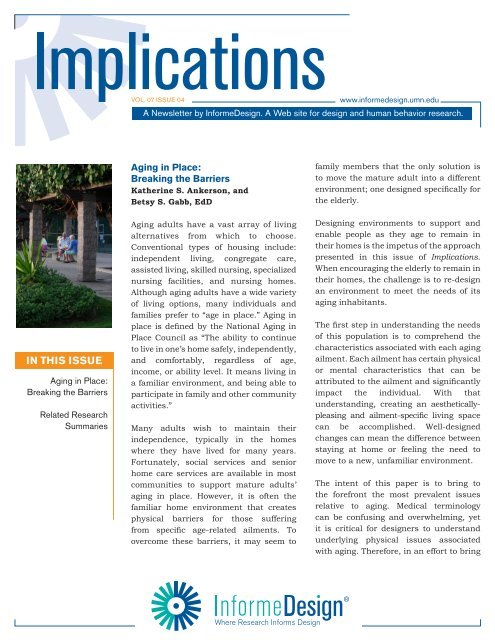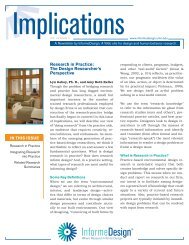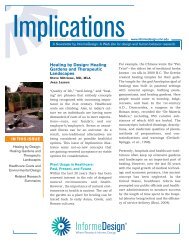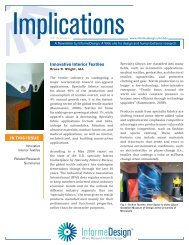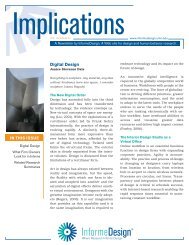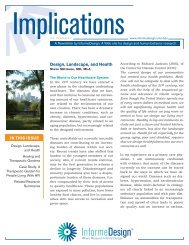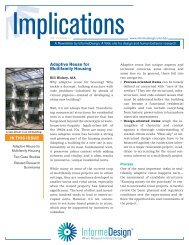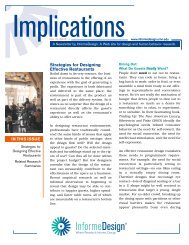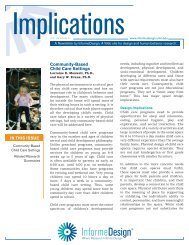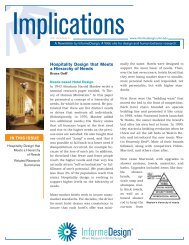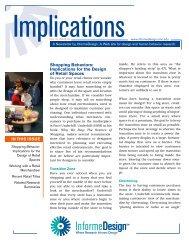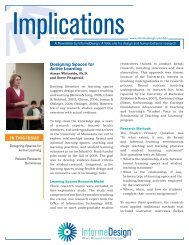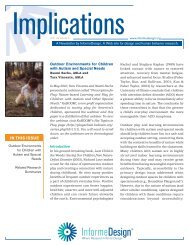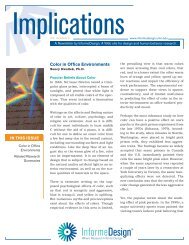Aging in Place: Breaking the Barriers - InformeDesign
Aging in Place: Breaking the Barriers - InformeDesign
Aging in Place: Breaking the Barriers - InformeDesign
Create successful ePaper yourself
Turn your PDF publications into a flip-book with our unique Google optimized e-Paper software.
Implications<br />
VOL. 07 ISSUE 04<br />
www.<strong>in</strong>formedesign.umn.edu<br />
A Newsletter by <strong>InformeDesign</strong>. A Web site for design and human behavior research.<br />
IN THIS ISSUE<br />
<strong>Ag<strong>in</strong>g</strong> <strong>in</strong> <strong>Place</strong>:<br />
Break<strong>in</strong>g <strong>the</strong> <strong>Barriers</strong><br />
Related Research<br />
Summaries<br />
<strong>Ag<strong>in</strong>g</strong> <strong>in</strong> <strong>Place</strong>:<br />
Break<strong>in</strong>g <strong>the</strong> <strong>Barriers</strong><br />
Ka<strong>the</strong>r<strong>in</strong>e S. Ankerson, and<br />
Betsy S. Gabb, EdD<br />
<strong>Ag<strong>in</strong>g</strong> adults have a vast array of liv<strong>in</strong>g<br />
alternatives from which to choose.<br />
Conventional types of hous<strong>in</strong>g <strong>in</strong>clude:<br />
<strong>in</strong>dependent liv<strong>in</strong>g, congregate care,<br />
assisted liv<strong>in</strong>g, skilled nurs<strong>in</strong>g, specialized<br />
nurs<strong>in</strong>g facilities, and nurs<strong>in</strong>g homes.<br />
Although ag<strong>in</strong>g adults have a wide variety<br />
of liv<strong>in</strong>g options, many <strong>in</strong>dividuals and<br />
families prefer to “age <strong>in</strong> place.” <strong>Ag<strong>in</strong>g</strong> <strong>in</strong><br />
place is def<strong>in</strong>ed by <strong>the</strong> National <strong>Ag<strong>in</strong>g</strong> <strong>in</strong><br />
<strong>Place</strong> Council as “The ability to cont<strong>in</strong>ue<br />
to live <strong>in</strong> one’s home safely, <strong>in</strong>dependently,<br />
and comfortably, regardless of age,<br />
<strong>in</strong>come, or ability level. It means liv<strong>in</strong>g <strong>in</strong><br />
a familiar environment, and be<strong>in</strong>g able to<br />
participate <strong>in</strong> family and o<strong>the</strong>r community<br />
activities.”<br />
Many adults wish to ma<strong>in</strong>ta<strong>in</strong> <strong>the</strong>ir<br />
<strong>in</strong>dependence, typically <strong>in</strong> <strong>the</strong> homes<br />
where <strong>the</strong>y have lived for many years.<br />
Fortunately, social services and senior<br />
home care services are available <strong>in</strong> most<br />
communities to support mature adults’<br />
ag<strong>in</strong>g <strong>in</strong> place. However, it is often <strong>the</strong><br />
familiar home environment that creates<br />
physical barriers for those suffer<strong>in</strong>g<br />
from specific age-related ailments. To<br />
overcome <strong>the</strong>se barriers, it may seem to<br />
family members that <strong>the</strong> only solution is<br />
to move <strong>the</strong> mature adult <strong>in</strong>to a different<br />
environment; one designed specifically for<br />
<strong>the</strong> elderly.<br />
Design<strong>in</strong>g environments to support and<br />
enable people as <strong>the</strong>y age to rema<strong>in</strong> <strong>in</strong><br />
<strong>the</strong>ir homes is <strong>the</strong> impetus of <strong>the</strong> approach<br />
presented <strong>in</strong> this issue of Implications.<br />
When encourag<strong>in</strong>g <strong>the</strong> elderly to rema<strong>in</strong> <strong>in</strong><br />
<strong>the</strong>ir homes, <strong>the</strong> challenge is to re-design<br />
an environment to meet <strong>the</strong> needs of its<br />
ag<strong>in</strong>g <strong>in</strong>habitants.<br />
The first step <strong>in</strong> understand<strong>in</strong>g <strong>the</strong> needs<br />
of this population is to comprehend <strong>the</strong><br />
characteristics associated with each ag<strong>in</strong>g<br />
ailment. Each ailment has certa<strong>in</strong> physical<br />
or mental characteristics that can be<br />
attributed to <strong>the</strong> ailment and significantly<br />
impact <strong>the</strong> <strong>in</strong>dividual. With that<br />
understand<strong>in</strong>g, creat<strong>in</strong>g an aes<strong>the</strong>ticallypleas<strong>in</strong>g<br />
and ailment-specific liv<strong>in</strong>g space<br />
can be accomplished. Well-designed<br />
changes can mean <strong>the</strong> difference between<br />
stay<strong>in</strong>g at home or feel<strong>in</strong>g <strong>the</strong> need to<br />
move to a new, unfamiliar environment.<br />
The <strong>in</strong>tent of this paper is to br<strong>in</strong>g to<br />
<strong>the</strong> forefront <strong>the</strong> most prevalent issues<br />
relative to ag<strong>in</strong>g. Medical term<strong>in</strong>ology<br />
can be confus<strong>in</strong>g and overwhelm<strong>in</strong>g, yet<br />
it is critical for designers to understand<br />
underly<strong>in</strong>g physical issues associated<br />
with ag<strong>in</strong>g. Therefore, <strong>in</strong> an effort to br<strong>in</strong>g
Implications<br />
www.<strong>in</strong>formedesign.umn.edu<br />
2<br />
issues of ag<strong>in</strong>g to <strong>the</strong> design community, medical<br />
research is <strong>in</strong>vestigated, and simplified to impactful<br />
elements, while ma<strong>in</strong>ta<strong>in</strong><strong>in</strong>g its <strong>in</strong>tegrity. The goal<br />
is to understand how ag<strong>in</strong>g impacts <strong>the</strong> daily life<br />
and activities of <strong>the</strong> elderly, and to design spaces<br />
accord<strong>in</strong>gly.<br />
In consultation with Julie Masters, University of<br />
Nebraska, Omaha Gerontology Department, research<br />
reveals n<strong>in</strong>e specific, age-related ailments that affect<br />
<strong>the</strong> built environment <strong>in</strong> various ways for those who<br />
would prefer to “age <strong>in</strong> place.” These ailments are<br />
most commonly associated with ag<strong>in</strong>g. Sometimes<br />
<strong>the</strong>y occur s<strong>in</strong>gly and sometimes <strong>the</strong>y occur <strong>in</strong><br />
comb<strong>in</strong>ation. It is <strong>the</strong>refore important to understand<br />
not only <strong>the</strong> characteristics of each, but <strong>the</strong>ir impact<br />
on ag<strong>in</strong>g <strong>in</strong>dividuals <strong>in</strong> <strong>the</strong> built environment. The<br />
most common ailments consist of:<br />
Arthritis<br />
Muscular Loss<br />
Cardiovascular Diseases<br />
Neurological Diseases<br />
Diabetes<br />
Osteoporosis<br />
Hear<strong>in</strong>g Impairment<br />
Vision Impairment<br />
Mental Disorders<br />
Prevalent Occurrences<br />
The range of ailments and disorders is broad, and<br />
variable <strong>in</strong> terms of effects. Here are a few of <strong>the</strong> most<br />
common ones afflict<strong>in</strong>g our ag<strong>in</strong>g population. The<br />
statistics are sober<strong>in</strong>g. Most people age 75+ have at<br />
least one jo<strong>in</strong>t affected by arthritis. From 2003-2005,<br />
50% of adults 65 years or older reported an arthritis<br />
diagnosis (MMWR, 2006). Women are impacted 2-3<br />
times more than men by rheumatoid arthritis. Most<br />
hear<strong>in</strong>g loss beg<strong>in</strong>s between 40-50 years of age. Over<br />
28% of <strong>in</strong>dividuals age 65 and older have a measurable<br />
hear<strong>in</strong>g impairment. By age 85, 50% of <strong>in</strong>dividuals<br />
have a hear<strong>in</strong>g impairment. Static acuity (sharpness<br />
of a stationary visual image) decl<strong>in</strong>es about age 40;<br />
and by <strong>the</strong> 70s, it has decreased by 30% compared<br />
to people <strong>in</strong> <strong>the</strong>ir 20s. Depth perception beg<strong>in</strong>s to<br />
decl<strong>in</strong>e dur<strong>in</strong>g <strong>the</strong> 50s and a 60-year-old person may<br />
require 2 to 3 times as much light to see as a 20-yearold;<br />
with <strong>the</strong> amount of light required doubl<strong>in</strong>g for<br />
each 13 years after <strong>the</strong> age of 20 (Centers for Disease<br />
Control and Prevention, 2009). One <strong>in</strong> two women<br />
and one <strong>in</strong> eight men over 50 years of age will have an<br />
osteoporosis-related fracture (National Osteoporosis<br />
Foundation, 2009). The physical limitations of ag<strong>in</strong>g<br />
do cause problems <strong>in</strong> some general areas, potentially<br />
affect<strong>in</strong>g people’s ability to live effectively on <strong>the</strong>ir own.<br />
These general limitations are briefly itemized below.<br />
Physical Limitations<br />
In general, ag<strong>in</strong>g-related ailments may cause some<br />
degree of problem <strong>in</strong> <strong>the</strong> follow<strong>in</strong>g areas:<br />
• gripp<strong>in</strong>g, p<strong>in</strong>ch<strong>in</strong>g, twist<strong>in</strong>g and squeez<strong>in</strong>g<br />
(hands)<br />
• bend<strong>in</strong>g or reach<strong>in</strong>g for objects<br />
• lift<strong>in</strong>g objects above shoulders or from below<br />
knees<br />
• gett<strong>in</strong>g <strong>in</strong>to and out of furniture and fixtures (e.g.,<br />
shower, toilet)<br />
• gett<strong>in</strong>g up or down <strong>in</strong>to a squat or floor position<br />
• climb<strong>in</strong>g and descend<strong>in</strong>g stairs<br />
• general mobility and flexibility<br />
• <strong>the</strong> need to rest even while do<strong>in</strong>g stationary tasks<br />
• slippery surfaces (<strong>in</strong>herent or due to water)<br />
• lift<strong>in</strong>g feet when walk<strong>in</strong>g versus shuffl<strong>in</strong>g<br />
• requir<strong>in</strong>g more light to see<br />
• requir<strong>in</strong>g more time to adapt to decreases or<br />
<strong>in</strong>creases <strong>in</strong> light<br />
• los<strong>in</strong>g ability to discern between shadows<br />
• los<strong>in</strong>g ability to see details<br />
Vision and Color<br />
Color plays a major role <strong>in</strong> visual perception of <strong>the</strong><br />
elderly. Accord<strong>in</strong>g to Lighthouse International, <strong>the</strong><br />
lens <strong>in</strong> <strong>the</strong> eye is a clear, layered structure attached<br />
to eye muscles that contract or relax to focus <strong>in</strong><br />
response to light (a loss of focus<strong>in</strong>g ability is <strong>the</strong><br />
reason many adults over 40 need read<strong>in</strong>g glasses).<br />
Yellow<strong>in</strong>g of <strong>the</strong> ag<strong>in</strong>g lens decreases color perception,<br />
and is noticeable at age 50. It becomes an <strong>in</strong>creas<strong>in</strong>g<br />
challenge to designers to consider “ag<strong>in</strong>g eyes” when<br />
Where Research Informs Design®
Implications<br />
www.<strong>in</strong>formedesign.umn.edu<br />
3<br />
select<strong>in</strong>g color palettes. Cool colors become difficult<br />
to discrim<strong>in</strong>ate and often appear as “gray,” beg<strong>in</strong>n<strong>in</strong>g<br />
at age 60. In o<strong>the</strong>r words, a space designed <strong>in</strong> light<br />
values of blues and greens may appear as gray, and<br />
not as <strong>the</strong> designer <strong>in</strong>tended. Unsaturated blues<br />
and greens are described as “calm<strong>in</strong>g” physiological<br />
colors; however, <strong>the</strong>se are often most difficult for <strong>the</strong><br />
matur<strong>in</strong>g eye to discrim<strong>in</strong>ate. Blue is one of <strong>the</strong> first<br />
colors to “gray.” It is typically best if a wide-range<br />
of colors are present. Warm colors and “saturated<br />
bright” colors are easiest to see. Red can be seen by<br />
most ag<strong>in</strong>g persons. Color contrast is very important,<br />
especially when differentiat<strong>in</strong>g <strong>the</strong> chair seat from<br />
<strong>the</strong> floor, f<strong>in</strong>d<strong>in</strong>g <strong>the</strong> toilet or <strong>the</strong> edge of a counter, or<br />
determ<strong>in</strong>at<strong>in</strong>g floor height changes. The best contrast<br />
for <strong>the</strong> elderly is black and white; however, this can<br />
appear sterile and unwelcom<strong>in</strong>g.<br />
In terms of artificial light, many fluorescent lamps are<br />
deficient <strong>in</strong> both red and blue-violet areas, allow<strong>in</strong>g<br />
color to loose its warmth and aliveness and giv<strong>in</strong>g <strong>the</strong><br />
sk<strong>in</strong> a pale, washed-out tone.<br />
• Height on door threshold could be a tripp<strong>in</strong>g<br />
hazard:Replace threshold with lower transition<br />
strip<br />
• Inability to dist<strong>in</strong>guish surface edges while<br />
travers<strong>in</strong>g stairs:Include high color contrast<br />
between adjacent surfaces, and at nos<strong>in</strong>gs<br />
• Slippery floor surface <strong>in</strong>doors or out: Use<br />
non-slick, water absorbent surface material<br />
• Unsecured throw rugs: Remove or affix rugs to <strong>the</strong><br />
floor surface below<br />
• Eyes unable to focus quickly from dark to<br />
light:Ensure lights have auto adjustment to slowly<br />
raise/lower light<strong>in</strong>g level<br />
• Porch light creates glare when approach<strong>in</strong>g<br />
<strong>the</strong> house:Shield lamp from view with a semitransparent<br />
or opaque reflector<br />
• Dark areas and shadows make open<strong>in</strong>g <strong>the</strong> front<br />
door difficult:Locate porch light on <strong>the</strong> same side<br />
of <strong>the</strong> door as <strong>the</strong> handle/lock<br />
• Navigat<strong>in</strong>g dark stairways: Install stair tread<br />
light<strong>in</strong>g with switch<strong>in</strong>g at <strong>the</strong> top and bottom of<br />
stairs (see Figure 1)<br />
Challenges and Recommendations<br />
While keep<strong>in</strong>g physical limitations <strong>in</strong> m<strong>in</strong>d, common<br />
activities may be well accommodated <strong>in</strong> <strong>the</strong> exist<strong>in</strong>g<br />
home environment with relatively straightforward,<br />
achievable solutions. Consider <strong>the</strong> follow<strong>in</strong>g<br />
recommendations noted <strong>in</strong> italics immediatly after<br />
each stated challenge. Also note that many of <strong>the</strong><br />
specific challenges/solutions apply across several<br />
situations.<br />
Enter<strong>in</strong>g/Exit<strong>in</strong>g Home<br />
• Difficulty grasp<strong>in</strong>g and turn<strong>in</strong>g circular knobs or<br />
handles:Utilize l<strong>in</strong>ear handles or pulls<br />
• Grasp<strong>in</strong>g and turn<strong>in</strong>g a key: Install a keyless<br />
lock<strong>in</strong>g system<br />
• No place to set items while open<strong>in</strong>g <strong>the</strong> door:<br />
Include small exterior bench to allow a place to<br />
rest and set items<br />
Fig.1: Light<strong>in</strong>g at stair treads supplements contrast<strong>in</strong>g edge<br />
differentiation.<br />
Where Research Informs Design®
Implications<br />
www.<strong>in</strong>formedesign.umn.edu<br />
4<br />
Meal Preparation<br />
• Grasp<strong>in</strong>g and turn<strong>in</strong>g circular knobs or<br />
handles:Utilize l<strong>in</strong>ear handles, or push buttons<br />
• Decreased ability to bend and lift: Use storage<br />
between knees and shoulders<br />
• Objects <strong>in</strong> top or bottom cab<strong>in</strong>ets needed <strong>in</strong><br />
preparation:Use roll-out shelves and kitchen<br />
organizers located between shoulders and knees<br />
(see Figure 2)<br />
• No rest<strong>in</strong>g area/seat to utilize while prepar<strong>in</strong>g<br />
meal:Remove portion of cab<strong>in</strong>etry to provide counter<br />
with chair<br />
• Inability to see small details/objects <strong>in</strong> prepar<strong>in</strong>g<br />
food:Include a magnifier with<strong>in</strong> easy reach,<br />
<strong>in</strong>crease light levels<br />
• Decreased depth perception: High color contrast<br />
between adjacent objects<br />
• Dark areas under hang<strong>in</strong>g storage: Utilize undercab<strong>in</strong>et<br />
light<strong>in</strong>g with lamps properly shielded from<br />
<strong>the</strong> eye <strong>in</strong> both sitt<strong>in</strong>g and stand<strong>in</strong>g positions<br />
• Not enough light to perform most basic<br />
functions:Add task light<strong>in</strong>g to decrease shadows<br />
and provide consistent light<strong>in</strong>g levels<br />
• Direct glare from exposed lamps make it difficult<br />
to focus:Ensure all lamps are properly hidden from<br />
view by location, semi-transparent or opaque<br />
reflector<br />
• Reflected glare makes tasks more difficult to see-<br />
Surface materials should have matte f<strong>in</strong>ish to<br />
elim<strong>in</strong>ate glare spots<br />
• Slippery floor surface: Use non-slick, water<br />
absorbent floor<strong>in</strong>g<br />
Eat<strong>in</strong>g<br />
• Difficulty mov<strong>in</strong>g food from preparation to d<strong>in</strong><strong>in</strong>g<br />
area:Provide wheeled cart to transport items<br />
housed <strong>in</strong> base cab<strong>in</strong>et.<br />
• Determ<strong>in</strong><strong>in</strong>g height of eat<strong>in</strong>g and sitt<strong>in</strong>g areas:Seat<br />
height at or slightly above knee level, lightweight<br />
(yet sturdy) chairs (see Figure 3)<br />
• Dim<strong>in</strong>ished muscle capacity <strong>in</strong> ris<strong>in</strong>g and<br />
sitt<strong>in</strong>g:Armed chairs with high apron help with<br />
sitt<strong>in</strong>g and ris<strong>in</strong>g<br />
• If natural light creates uncomfortable glare:Install<br />
adjustable bl<strong>in</strong>ds, shades, or drapery over all<br />
natural light sources<br />
Personal Hygiene<br />
• May tire while perform<strong>in</strong>g personal hygiene<br />
tasks:Seat<strong>in</strong>g at counter<br />
• Grasp<strong>in</strong>g and turn<strong>in</strong>g circular knobs and<br />
handles:Utilize l<strong>in</strong>ear handles, pulls and straight<br />
toilet paper holders (see Figure 4)<br />
• Objects <strong>in</strong> lower cab<strong>in</strong>ets needed <strong>in</strong> activities: <strong>Place</strong><br />
storage <strong>in</strong> a height zone between knees and<br />
shoulders<br />
Fig.2: Install kitchen rail organizers for common-use items.<br />
Fig.3: Arm chair with open<br />
apron assists <strong>in</strong> ris<strong>in</strong>g.<br />
Fig.4: Decrease number of specific<br />
actions for common tasks.<br />
Where Research Informs Design®
Implications<br />
www.<strong>in</strong>formedesign.umn.edu<br />
5<br />
• Stepp<strong>in</strong>g <strong>in</strong>to and out of shower: True walk-<strong>in</strong> with<br />
no threshold, non-slip surface<br />
• Tir<strong>in</strong>g dur<strong>in</strong>g shower: Seat/bench with<strong>in</strong> shower<br />
stall<br />
• Reflected glare makes tasks more difficult to<br />
see:Surface materials should have matte f<strong>in</strong>ish to<br />
elim<strong>in</strong>ate glare spots<br />
• Shadows cast <strong>in</strong> shower/tub appear as<br />
objects/ obstacles:Direct/<strong>in</strong>direct light<strong>in</strong>g source<br />
should be <strong>in</strong>stalled over <strong>the</strong> shower/tub<br />
• Inability to see small details/objects: Provide<br />
magnifier, magnify<strong>in</strong>g mirror, and adequate light<strong>in</strong>g<br />
levels<br />
• Normal night light<strong>in</strong>g situation not bright enough<br />
to be useful:Adjustable night light, light entire<br />
pathway to bedroom<br />
• Closet racks and shelv<strong>in</strong>g hard to access: Height<br />
adjustable closet racks and shelv<strong>in</strong>g (see Figure<br />
5)<br />
• Slippery floor surface made slicker by water: Use<br />
non-slick, water absorbent floor<strong>in</strong>g<br />
• Difficulty dist<strong>in</strong>guish<strong>in</strong>g surface edges due to<br />
decreased depth perception:High color contrast<br />
between adjacent surfaces<br />
Sleep<strong>in</strong>g<br />
• Gett<strong>in</strong>g <strong>in</strong>to and out of <strong>the</strong> bed: Lower bed height<br />
to seat<strong>in</strong>g level<br />
• Open<strong>in</strong>g/clos<strong>in</strong>g w<strong>in</strong>dows for ventilation: Large<br />
handles or knob to open, or automatic adjustment<br />
• Normal night light not bright enough to be useful:<br />
Adjustable night light light<strong>in</strong>g entire pathway to<br />
and from room<br />
Leisure Activities<br />
• Seat height of chairs, sofas: Seat height slightly<br />
above knee, auxiliary tables at mid-torso height<br />
• On/off switches on light sources: Large button,<br />
rocker panel, or motion detected<br />
• Dim<strong>in</strong>ished muscle capacity <strong>in</strong> ris<strong>in</strong>g and<br />
sitt<strong>in</strong>g:Armed chairs to help sitt<strong>in</strong>g and ris<strong>in</strong>g (see<br />
Figure 6)<br />
• Severe change <strong>in</strong> light <strong>in</strong>tensity from area to<br />
area:Ensure consistent light source and <strong>in</strong>tensity<br />
between areas<br />
• Shadows may appear as actual objects or<br />
obstacles:Consistent light sources throughout<br />
room to decrease dark areas<br />
• Direct glare from exposed lamps make it difficult to<br />
focus:Ensure all lamps<br />
are properly hidden<br />
from view by location,<br />
semi-transparent, or<br />
opaque reflector<br />
• Natural light creates<br />
u n c o m f o r t a b l e<br />
glare:Install adjustable<br />
bl<strong>in</strong>ds, shades or<br />
drapery over all natural<br />
light sources<br />
Fig.6: To aid <strong>in</strong> ris<strong>in</strong>g and sitt<strong>in</strong>g,<br />
select arm chairs with<br />
height-appropriate arms and<br />
open aprons.<br />
Fig.5: Reorganize cloth<strong>in</strong>g storage to reachable zone.<br />
Where Research Informs Design®
Implications<br />
www.<strong>in</strong>formedesign.umn.edu<br />
6<br />
Clean<strong>in</strong>g and Laundry<br />
• <strong>Place</strong>ment of appliances require bend<strong>in</strong>g: Appliances<br />
placed above floor to decrease bend<strong>in</strong>g<br />
• Need for objects on storage shelves above shoulder<br />
height:Locate storage <strong>in</strong> a height zone between<br />
shoulders and knees (see Figure 7)<br />
• No rest area while fold<strong>in</strong>g or iron<strong>in</strong>g clo<strong>the</strong>s: Provide<br />
seat<strong>in</strong>g at counter, table, or task area<br />
• Dark areas under hang<strong>in</strong>g storage: Under-cab<strong>in</strong>et<br />
•<br />
light<strong>in</strong>g<br />
Grasp<strong>in</strong>g and turn<strong>in</strong>g circular knobs and<br />
handles:Utilize l<strong>in</strong>ear handles or pulls<br />
• Objects <strong>in</strong> lower cab<strong>in</strong>ets needed <strong>in</strong><br />
preparation:Storage placed <strong>in</strong> a height zone<br />
between knees and shoulders<br />
• Requires more light to perform most basic<br />
functions:Additional task light<strong>in</strong>g to decrease<br />
shadows and provide consistency<br />
Conclusion<br />
The implications for ag<strong>in</strong>g <strong>in</strong> place discussed <strong>in</strong><br />
this article only touch <strong>the</strong> ‘tip of <strong>the</strong> iceberg.’ Each<br />
ailment commonly associated with ag<strong>in</strong>g has<br />
physical and mental characteristics which can be<br />
significantly impacted (for better or worse) by <strong>the</strong><br />
environment. Sometimes <strong>the</strong> decision to age <strong>in</strong><br />
place is not appropriate, necessitated by medical<br />
concerns However, with appropriate environmental<br />
accomodations, ag<strong>in</strong>g <strong>in</strong> place is a possibility for most<br />
<strong>in</strong>dividuals.<br />
References<br />
—The National <strong>Ag<strong>in</strong>g</strong> <strong>in</strong> <strong>Place</strong> Council. (2009).<br />
Available from http://www.naipc.<br />
org/Default.aspx?tabid=103<br />
—Hootman J., Bolen J., Helmick C., & Langmaid<br />
G. (2006). Prevalence of doctor-diagnosed<br />
arthritis and arthritis-attributable activity<br />
limitation-United States, 2003-2005.<br />
—Centers for Disease Control and Prevention. (2009)<br />
National Center for Health Statistics. Available<br />
from www.cdc.gov/nchs/nhis.htm<br />
—National Osteoporosis Foundation.<br />
(2009). Available from www.nof.org<br />
—Lighthouse International. (2009). Available from<br />
www.lighthouse.org/medical/<strong>the</strong>-ag<strong>in</strong>g-eye<br />
Resources<br />
—www.aarp.org/universalhome<br />
—www.ag<strong>in</strong>g<strong>in</strong>place.org<br />
—www.homemods.org<br />
—www.abledata.com<br />
—www.seniorresource.com<br />
—www.medem.com/medlib/60<br />
—www.design.ncsu.edu<br />
—www.cornellag<strong>in</strong>g.com<br />
—www.build4boomers.com<br />
—www.nahbrc.com<br />
—www.dynamicliv<strong>in</strong>g.com<br />
—www.accesstoday.com<br />
—www.geocel.com<br />
—www.adi/home.htm<br />
—www.aidsforarthritis.com<br />
—www.comforthouse.com<br />
—www.activeforever.com<br />
—www.keybowl.com<br />
—www.lifewi<strong>the</strong>ase.com<br />
Fig.7: <strong>Place</strong> storage with<strong>in</strong> a zone from knee-to shoulder-level<br />
Where Research Informs Design®
Implications<br />
www.<strong>in</strong>formedesign.umn.edu<br />
7<br />
About <strong>the</strong> Authors<br />
Ka<strong>the</strong>r<strong>in</strong>e S. Ankerson, MS,<br />
NCARB certified, IDEC, is<br />
Associate Dean and Professor<br />
of Interior Design <strong>in</strong> <strong>the</strong> College<br />
of Architecture at <strong>the</strong> University<br />
of Nebraska-L<strong>in</strong>coln where she<br />
has taught s<strong>in</strong>ce 1996. Previous<br />
experience as a Professor at<br />
both Radford University and<br />
Wash<strong>in</strong>gton State University came follow<strong>in</strong>g 15 years<br />
as an architecture and <strong>in</strong>terior design practitioner.<br />
Ankerson’s work lies <strong>in</strong> <strong>the</strong> areas of translation of<br />
research from medical and o<strong>the</strong>r professions as<br />
formative issues <strong>in</strong> design of <strong>the</strong> built environment,<br />
pr<strong>in</strong>cipally related to senior liv<strong>in</strong>g environments. She<br />
has authored multiple books and authored multiple<br />
articles and is a frequent presenter.<br />
Betsy S. Gabb, EdD, FIDEC,<br />
IIDA, is a Professor and<br />
Program Director <strong>in</strong> <strong>the</strong><br />
Interior Design Program <strong>in</strong> <strong>the</strong><br />
College of Architecture at <strong>the</strong><br />
University of Nebraska-L<strong>in</strong>coln.<br />
Gabb has served on <strong>the</strong> Board<br />
of Directors for <strong>the</strong> Council of<br />
Interior Design Accreditation<br />
(CIDA) and is currently serv<strong>in</strong>g as Chair of CIDA’s<br />
Standards Committee. In <strong>the</strong> past, she has served as<br />
<strong>the</strong> Midwest Regional Chair for <strong>the</strong> Interior Design<br />
Educators Council (IDEC). Gabb’s research <strong>in</strong>terests<br />
<strong>in</strong>clude teach<strong>in</strong>g strategies for design and <strong>the</strong> design<br />
of senior liv<strong>in</strong>g environments. Her work has been<br />
published <strong>in</strong> a variety of publications <strong>in</strong>clud<strong>in</strong>g <strong>the</strong><br />
Journal of Interior Design and IIDA’s Perspective.<br />
Related Research Summaries<br />
<strong>InformeDesign</strong> has many Research Summaries<br />
about ag<strong>in</strong>g <strong>in</strong> place, and o<strong>the</strong>r related topics. This<br />
knowledge will be valuable to you as you consider<br />
your next design solution and is worth shar<strong>in</strong>g with<br />
your clients and collaborators.<br />
“Age and Gender Affect Color Memory”<br />
—Color Research and Application<br />
“Why Older People Move or Wish to Move”<br />
—Hous<strong>in</strong>g, Theory and Society<br />
“Clarify<strong>in</strong>g <strong>Ag<strong>in</strong>g</strong> <strong>in</strong> <strong>Place</strong> Vocabulary”<br />
—Hous<strong>in</strong>g and Society<br />
“Decreas<strong>in</strong>g Risk Falls for Seniors”<br />
—Journal of Safety Research<br />
“How People Interact with Doors”<br />
—Applied Ergonomics<br />
“Effect of Daylight on Cataract Vision”<br />
—Color Research and Application<br />
“Age and Illum<strong>in</strong>ace Affect Color Perception”<br />
—LEUKOS: Journal of <strong>the</strong> Illum<strong>in</strong>at<strong>in</strong>g Eng<strong>in</strong>eer<strong>in</strong>g<br />
Society of America<br />
Images Courtesy of<br />
Caren Mart<strong>in</strong> (p.1)<br />
Ka<strong>the</strong>r<strong>in</strong>e S. Ankerson (rema<strong>in</strong>der)<br />
The Mission<br />
The Mission of <strong>InformeDesign</strong> is to facilitate designers’<br />
use of current, research-based <strong>in</strong>formation as a decisionmak<strong>in</strong>g<br />
tool <strong>in</strong> <strong>the</strong> design process, <strong>the</strong>reby<br />
<strong>in</strong>tegrat<strong>in</strong>g research and practice.<br />
Creator:<br />
Found<strong>in</strong>g Sponsor:<br />
© 2002, 2005 by <strong>the</strong> Regents of <strong>the</strong> University of M<strong>in</strong>nesota.


